Telocytes and putative stem cells in the lungs: electron microscopy, electron tomography and laser scanning microscopy
- PMID: 21858462
- PMCID: PMC3168741
- DOI: 10.1007/s00441-011-1229-z
Telocytes and putative stem cells in the lungs: electron microscopy, electron tomography and laser scanning microscopy
Abstract
This study describes a novel type of interstitial (stromal) cell - telocytes (TCs) - in the human and mouse respiratory tree (terminal and respiratory bronchioles, as well as alveolar ducts). TCs have recently been described in pleura, epicardium, myocardium, endocardium, intestine, uterus, pancreas, mammary gland, etc. (see www.telocytes.com ). TCs are cells with specific prolongations called telopodes (Tp), frequently two to three per cell. Tp are very long prolongations (tens up to hundreds of μm) built of alternating thin segments known as podomers (≤ 200 nm, below the resolving power of light microscope) and dilated segments called podoms, which accommodate mitochondria, rough endoplasmic reticulum and caveolae. Tp ramify dichotomously, making a 3-dimensional network with complex homo- and heterocellular junctions. Confocal microscopy reveals that TCs are c-kit- and CD34-positive. Tp release shed vesicles or exosomes, sending macromolecular signals to neighboring cells and eventually modifying their transcriptional activity. At bronchoalveolar junctions, TCs have been observed in close association with putative stem cells (SCs) in the subepithelial stroma. SCs are recognized by their ultrastructure and Sca-1 positivity. Tp surround SCs, forming complex TC-SC niches (TC-SCNs). Electron tomography allows the identification of bridging nanostructures, which connect Tp with SCs. In conclusion, this study shows the presence of TCs in lungs and identifies a TC-SC tandem in subepithelial niches of the bronchiolar tree. In TC-SCNs, the synergy of TCs and SCs may be based on nanocontacts and shed vesicles.
Figures
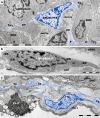
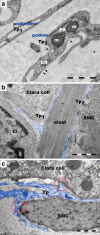

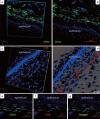

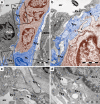
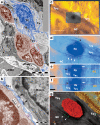


References
-
- Barth M, Schumacher H, Kuhn C, Akhyari P, Lichtenberg A, Franke WW. Cordial connections: molecular ensembles and structures of adhering junctions connecting interstitial cells of cardiac valves in situ and in cell culture. Cell Tissue Res. 2009;337:63–77. doi: 10.1007/s00441-009-0806-x. - DOI - PubMed
-
- Bell G, Mooers AO. Size and complexity among multicellular organisms. Biol J Linn Soc Lond. 1997;60:345–363. doi: 10.1111/j.1095-8312.1997.tb01500.x. - DOI
Publication types
MeSH terms
LinkOut - more resources
Full Text Sources
Medical
Research Materials

